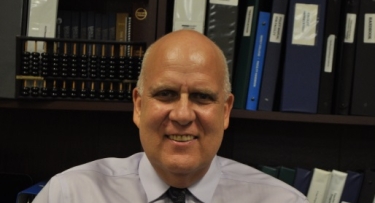Interview with Dr. William Farber, New York State Mathematics Educators Hall of Famer

Mercy College Associate Professor of Mathematics Education Dr. William Farber is an inductee of the New York State Mathematics Educators Hall of Fame, sponsored by the New York State Association of Mathematics Supervisors (NYSAMS). The School of Education is very proud to have such an outstanding mathematician and dedicated colleague as part of our community.
Thinking back to your own childhood, when did you realize that you had special interest in and talent for mathematics? How you come to enjoy mathematics?
I have always been fascinated with numbers and the magical way that they work. As a youngster I began working at my Dad’s produce stand in the Bronx, New York. At the age of five, I was selling shopping bags to customers for a nickel per bag. As I got older, I was allowed to pack, weigh, and sell all types of produce and make change for customers, without the use of a calculator. My dad was my first math teacher and, out of necessity, his approach was through real life applications. I applied all that I learned from my dad to the classroom, such as measurement skills, fraction manipulation, mental math, spatial relations, and number operations. My love for math has remained throughout my educational life and career. During middle school, I was fortunate to have a teacher who had a profound influence on my decision to ultimately pursue a career in mathematics. Lawrence Weinberg was a dedicated instructor who showed great interest in his students and made math fun. He was a significant role model.
When and why did you decide to become a teacher of mathematics? Was this always your goal?
After graduating from high school, I enlisted in the U.S. Navy and served four years during the war in Vietnam. While in the Navy, I took correspondence courses in mathematics. After being discharged, I initially studied at Bronx Community College and then transferred to Manhattan College majoring in mathematics with no specific career focus. My wife, Deborah, encouraged me to consider teaching as a profession. She recognized my potential as a teacher and was well aware of my enthusiasm for mathematics. After graduating from college, I was hired by Dr. William Pratella (Superintendent of the Mount Vernon Schools) and filled a six-month temporary teaching position at the A.B. Davis Middle School in Mount Vernon, NY. I taught 7th and 8th grade mathematics. I found my true calling and the students enjoyed my interactive teaching methods. Making math relevant for all students, including those who experienced math anxiety was imperative.
You worked for many years as a mathematics teacher at John Peter Tetard Junior High School. Which is the most cherished memory of your time as a mathematics teacher?
I was hired as a ninth grade teacher in the Bronx and was fortunate to be in an environment with a strong mathematics faculty. The chairperson of the department, Dr. Harold Bailey, was a fine mathematician and supervisor, and a great mentor. I developed methods of teaching that were innovative and helped to make math come alive for students. The use of hands-on materials, real-world models, technology, guest speakers, music and sports helped to significantly motivate students.
In your opinion, what is the best way to help young children to enjoy mathematics and to become successful in learning mathematics?
It is very important to create a supportive classroom environment, where students have the freedom and comfort to express themselves without reservation. Also, it is essential to make mathematics ‘come alive’ for young children. This can be accomplished using motivational techniques, such as the effective use of manipulative materials, incorporating learning centers, presenting relevant early childhood mathematics literature, using technology, and having children work together in cooperative group settings. Teachers should also incorporate mathematics that is functionally relevant and familiar to real life situations that children experience and can relate to. These are a few methods that will build a child’s ego strength and help desensitize math anxiety, which is so prevalent in our society.
Do you have a favorite mathematical activity or problem that you are partial to and enjoy sharing with your students and colleagues?
There are so many mathematical activities that I enjoy sharing with students, teachers, and colleagues throughout the tears, but if I had to choose one, it would be the “Birthday Problem”. The Birthday Problem is a very famous problem in combinatorial probability. The classical statement of the problem is to find the probability that among n students in a classroom, at least two students will have the same birthday (both month and day). The problem is well known and the solution is a bit surprising, and gets students to think about probability theory in a hands-on, motivational, enjoyable way.
